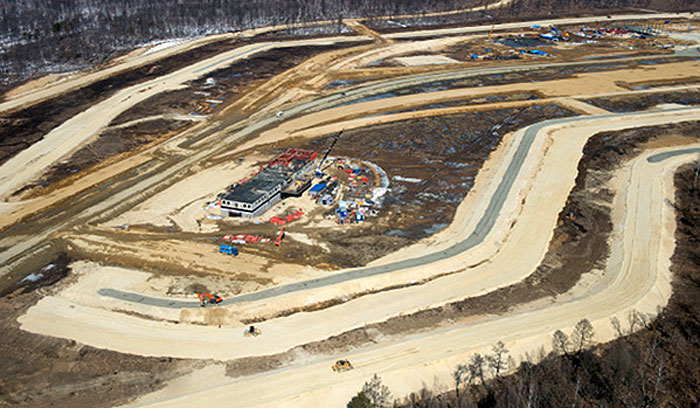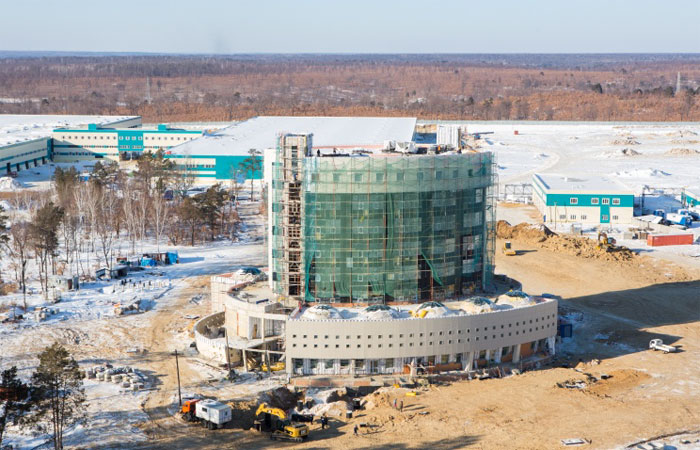.
24.02.2014

The construction of the Vostochny space centre becomes the top priority for the country after the Olympic construction has been completed and emphasis should be placed on this site now, Russia's Vice-Premier Dmitry Rogozin said after visiting the facility in the Amur Region.
Rogozin considers it necessary to increase several-fold the number of workers engaged in the construction of the cosmodrome Vostochny (Eastern). He said this herer on Monday during an inspection of the spaceport which is under construction in Amur Region.
"Independent experts maintain that the number of workers at the cosmodrome Vostochny must be multiplied up to 15,000, at least," he pointed out.
Sergei Makarov, chief of the Federal unitary enterprise "SpetsStrojTekhnologii" Federal Agency for Special-Purpose Construction, said that at present the construction project employs 5,200-5,300 workers. Contractor are to reach out to the maximum number of workers engaged in the space-industry consruction project by the third quarter of 2014 "when the number of workers will be 8,000," Makarov pointed out. Rogozin called for multiplying the workforce in the project.
The construction of the cosmodrome Vostochny, near Uglegorsk Township in Amur Region, was started in the middle of 2012. The first launch of a space rocket is to be effected by 2015 and the launchings of manned spaceships are to begin by 2018.
First space launch from Vostochny due in Dec 2015 - Rogozin
Manned space missions will begin from the Vostochny spaceport, Amur region, in 2018, and Angara will be the launch vehicle, Russian Deputy Prime Minister Dmitry Rogozin said.
"The maiden launch of the Soyuz-2 LV from the Vostochny spaceport will be done in December 2015, and the manned Angara mission from the second launch site in 2018," Rogozin wrote on Twitter while visiting the Vostochny construction site.
The Vostochny spaceport with a total area nearing 700 square kilometers is under construction near the town of Uglegorsk in the Amur region, Russia's Far East.
The project was launched in the middle of 2012.
The Soyuz-2 launch site in Vostochny will provide launches of Soyuz-2.1a, Soyuz-2.1b and Soyuz-2.1v LV carrying satellites and resupply ships.
The site will handle at least ten space launches a year.
Consistent with tender documentation, the Angara launch site will support Angara-1.2 light LV, Angara-3 medium LV and Angara-5 heavy LV.
Initially, the Angara launch site will incorporate a launcher and infrastructure to support Angara LV carrying spacecraft.
Later on, the launch site will provide satellite, oxygen-hydrogen upper stage and manned spaceship missions.
Workforce building Vostochny spaceport must grow at least to 15,000 - Rogozin
More workers should be recruited to build the Vostochny spaceport in the Amur region, Russian Deputy Prime Minister Dmitry Rogozin said.
"Independent experts say that the number of workers employed in Vostochny should grow manifold, at least to 15,000," Rogozin said on Monday as he was visiting the construction site.
"Some 5,200-5,300 workers are building [Vostochny] now and the workforce will reach its maximum, 8,000, by the third quarter of 2014," Spetsstroy of Russia's Spetsstroytekhnologii head Sergei Makarov told the deputy prime minister.
Russian PM wants Tsiolkovsky town to accommodate space industry intellectuals
Russian Deputy Prime Minister Dmitry Rogozin has ordered builders to strictly comply with the schedule in the construction of the Vostochny spaceport in the Amur region.
"You should think about the construction of not only the launch sites but also of the new town, Tsiolkovsky," he told contractors at a conference dedicated to the Vostochny project.
"Vostochny is a point of growth for the entire Russian Far East, a breath of fresh air for the Far Eastern region. Vostochny will not just provide for the space independence of Russia; the new town will accommodate space industry intellectuals," Rogozin said.
He ordered the builders "to display iron discipline in their compliance with the schedule."
"A Soyuz-2 launch vehicle is supposed to take off from here by the end of 2015, and we will not accept any excuses. An Angara will blast off from Plesetsk in the end of the second quarter of this year. We have launch vehicles, now we need launch sites," the vice-premier declared.
He ordered the builders engaged in the Vostochny project "to tell the Russian government immediately about all problems they were encountering."
Quelle:Voice of Russia
.
First space launch from Vostochny due in Dec 2015 - Rogozin
Manned space missions will begin from the Vostochny spaceport, Amur region, in 2018, and Angara will be the launch vehicle, Russian Deputy Prime Minister Dmitry Rogozin said.
"The maiden launch of the Soyuz-2 LV from the Vostochny spaceport will be done in December 2015, and the manned Angara mission from the second launch site in 2018," Rogozin wrote on Twitter while visiting the Vostochny construction site.
The Vostochny spaceport with a total area nearing 700 square kilometers is under construction near the town of Uglegorsk in the Amur region, Russia's Far East.
The project was launched in the middle of 2012.
The Soyuz-2 launch site in Vostochny will provide launches of Soyuz-2.1a, Soyuz-2.1b and Soyuz-2.1v LV carrying satellites and resupply ships.
The site will handle at least ten space launches a year.
Consistent with tender documentation, the Angara launch site will support Angara-1.2 light LV, Angara-3 medium LV and Angara-5 heavy LV.
Initially, the Angara launch site will incorporate a launcher and infrastructure to support Angara LV carrying spacecraft.
Later on, the launch site will provide satellite, oxygen-hydrogen upper stage and manned spaceship missions.
Quelle: Voice of Russia
.
Update: 25.02.2014
.
Construction of technical facilities at Vostochny spaceport to start in 2015
A launch site for super-heavy lift vehicles will be built at the Vostochny Cosmodrome
.

Vostochny Cosmodrome
.
Russia will create its new Angara space complex at the Far Eastern Vostochny Cosmodrome in two stages for unmanned and piloted missions - and will have to commence the first stage in 2015 in order to be able to complete it in 2018, Federal Space Agency (Roscosmos) Head Oleg Ostapenko said on Monday, February 24.
In December 2013, specialists chose sites for Angara facilities at the cosmodrome and transported the carrier rocket’s mockup from Moscow-based Khrunichev Space Centre that made it to the spaceport in the Far Eastern Amur Region.
Roscosmos and the Agency for Special Construction Project (Spetsstroy), the main contractor in this project, have approved a schedule of work. Spetsstroy is now stepping up work to make up for delays caused by bad weather.
The first stage of the project - construction of roads at the cosmodrome - has been completed. The second stage is proceeding as scheduled and is to be completed in December 2014. More than 400 social, engineering and transport infrastructure facilities, 115 km of roads and 125 km of railroads will be built at the cosmodrome.
Vostochny should become operational in 2015 and start sending manned missions in 2018. The comsodrome is intended for launching automatic and piloted space missions under national, international and commercial programmes. Its construction started in 2012 and the first launch is expected to be carried out in by 2015 on board Soyuz-2 light carrier rockets. By 2018, it will be ready to launch heavy Angara-5A rockets. The cosmodrome will also have infrastructure for future piloted missions.
Russia plans to launch its new Angara carrier rocket this year. The new carrier rocket will be used to launch both civilian and military spacecraft and for international space cooperation projects.
Ostapenko said earlier that work on the Angara carrier rocket was proceeding as scheduled.
“We stick to the schedule. Work is now in progress to create a medium lift launch vehicle and in parallel with that we will move over to the heavy version Angara-5. Work is also underway to create the Soyuz-2 rocket and space system, and we plan to use the builders’ capacities for constructing the launch pad for Angara,” Ostapenko said.
A super-heavy lift launch vehicle will be able to carry a payload of 80 tonnes to low-earth orbits. In the future, its capacity can be increased to 160 tonnes and more.
The launch site for super-heavy lift vehicles will be built at the Vostochny Cosmodrome.
Khrunichev Space Centre Director-General Alexander Seliverstov said that the Angara development had reached the flight test stage and the focus was on finalising the launch site in Plesetsk.
He said that light and heavy versions of Angara rockets would be launched in 2014 and work was proceeding as scheduled. “The first rocket is to be launched in 2014,” Seliverstov said.
Angara will allow Russia to launch all kinds of spacecraft to any orbit. Now Russia can launch heavy satellites only aboard Proton rockets from Baikonur, which it leases from Kazakhstan for about 115 million U.S. dollars a year.
According to Khrunichev, a big advantage of the new rocket carrier is that “it is a universal space rocket system” capable of taking three types of rockets into space: light with a payload of up to 3.5 tonnes, medium with a payload of up to 14.6 tonnes, and heavy with a payload of up to 24.5 tonnes.
Medium lift and heavy lift launch vehicles can take payloads to the geostationary orbit as well.
The vehicle uses a unique engineering solution: the carrier can be assembled of the same modules. Their maximum number is five in a heavy version, three in a medium version, and one in a light version. They can all be launched form the same pad, not like now at Baikonur where each carrier requires its own launching pad.
The Angara class of rockets comprises four types of vehicles, with payload capacities ranging between 3.7 tones /light class, intended for low orbits/ and 28.5 tonnes.
The rockets are based on a universal rocket module powered by the RD-191 engine using kerosene and liquid oxygen. One such module makes up the first stage of the light class Angara 1.1 and Angara 1.2 boosters. Their second stages are different. The medium and heavy class boosters Angara-3 and Angara 4 are an extension of the light class types with additional three or four universal modules. Depending on the specific tasks, the booster can be equipped with the Briz-M or KVRB accelerator units.
Quelle: ITAR TASS
4837 Views

